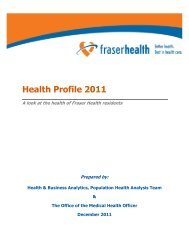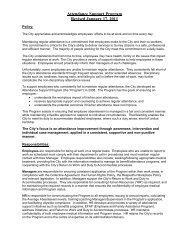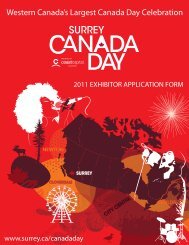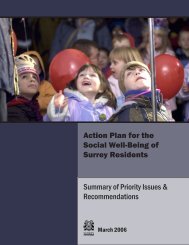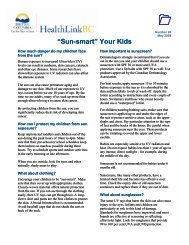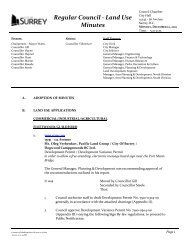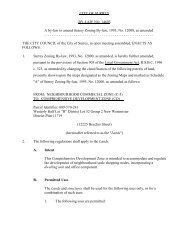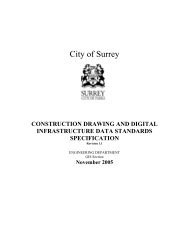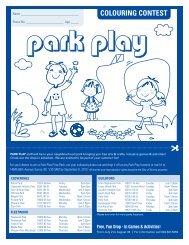Blackie Spit Park: Wildlife Habitat Enhancement Plan - City of Surrey
Blackie Spit Park: Wildlife Habitat Enhancement Plan - City of Surrey
Blackie Spit Park: Wildlife Habitat Enhancement Plan - City of Surrey
You also want an ePaper? Increase the reach of your titles
YUMPU automatically turns print PDFs into web optimized ePapers that Google loves.
Management Unit 2: Rail Side<br />
1.0 Existing Conditions<br />
Management Unit 2 west <strong>of</strong> the dyke assess road is a variable mixture <strong>of</strong> volunteer and planted, native<br />
and introduced shrubs, and brambles encroaching into an area <strong>of</strong> grasses and forbes, and a grove <strong>of</strong><br />
birch (Betula papyrifera) trees (Drawing 2). East <strong>of</strong> the dyke access road vegetation is a mixture<br />
<strong>of</strong> largely invasive (blackberry) and native shrubs with a central grass/forb area.<br />
West <strong>of</strong> dyke access road<br />
At the east end <strong>of</strong> this section, just west <strong>of</strong> the dyke access road, vegetation is primarily woody,<br />
comprising birch, one Douglas fir (Pseudotsuga menziesii), and a row <strong>of</strong> Lombardy poplars () along<br />
the road side, with an undergrowth <strong>of</strong> dense Himalayan blackberry. The west end is vegetated with<br />
about 10 planted lodgepole pines (Pinus contorta) and volunteer deciduous trees, shrubs, and<br />
brambles.<br />
The remainder <strong>of</strong> the area is largely long, uncut pasture grasses, in some places mixed with Canada<br />
thistle (Cirsium arvense), reeds Juncus sp., or stinging nettle (Urtica dioica), and in some places<br />
replaced by patches <strong>of</strong> reed canarygrass (Phalaris arundinacea). An area <strong>of</strong> policeman’s helmet<br />
(Impatiens glandulifera) grows near the intersection <strong>of</strong> the road and the access road to the gardens.<br />
About half <strong>of</strong> the area is also occupied by woody vegetation (Figure 11). Woody species include<br />
blackberry (scattered, plus one large patch), red elderberry (Sambucus racemosa) (mostly stressed<br />
and dying or dead), broom (near the west end), or planted trees (up to about 5 m high), including oak<br />
(Quercus sp.), rowan (European ash) (Sorbus aucuparia), 1 walnut (Juglans sp.), 1 blue spruce<br />
(Picea pungens), 2 Douglas fir, and about 10 lodge-pole pine (in the western half). (A total <strong>of</strong> about<br />
20 pines are planted in the MU.)<br />
The soils consist <strong>of</strong> more than 90 cm <strong>of</strong> organic topsoil, <strong>of</strong>ten with lenses <strong>of</strong> grey clay. During the<br />
late July field visit, the moisture content <strong>of</strong> the upper 30 to 60 cm decreased toward the west end <strong>of</strong><br />
the central area and the vegetation, particularly the condition <strong>of</strong> the elderberry, reflected the change<br />
in available moisture. At the west end <strong>of</strong> the central area, the upper 30 cm was completely dry.<br />
East <strong>of</strong> dyke access road<br />
The plant species growing east <strong>of</strong> the dyke access road include blackberry, rose, broom, elderberry,<br />
with some individual alder, Pacific crabapple and a domestic cherry (Prunus sp.) (Figure 12). The<br />
central area, is kept open by people seeking access to the water’s edge, or a place to build a fire and<br />
perhaps to party. The central vegetation is low grasses surrounded by tall grasses including reed<br />
canarygrass and forbs such as yarrow, tansy, goldenrod, thistle, morning glory (Convolvulus<br />
arvensis), and hairy cat’s ear. A trail through the MU connects the dyke access road with trails east<br />
<strong>of</strong> the park, including to the aeroplane museum.<br />
Soils in the clearing are up to two inches or so <strong>of</strong> firm (impenetrable to soil prob) sandy, gravelly<br />
loam. Mole activity suggests sand occurs beneath the surface layer.<br />
<strong>Blackie</strong> <strong>Spit</strong> <strong>Park</strong>: <strong>Wildlife</strong> <strong>Habitat</strong> <strong>Enhancement</strong> <strong>Plan</strong> – Management Unit 2 28



